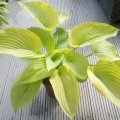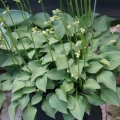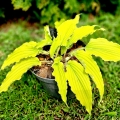Online Shop
128
Royal Horticultural Society
Gold Medals
Royal Horticultural Society
Gold Medals
- Home
- Other Plants
- About Agapanthus
About Agapanthus

Agapanthus – the Lily of Love – come from South Africa and are herbaceous perennials, belonging to the family Amaryllidaceae which contains six species and a number of subspecies. Some are hardy and some tender. They produce a rootstock with an abundance of thick fleshy roots and mainly tight crowns of buds, strap shaped leaves, and umbels of mainly blue flowers. Not strictly bulbous but rhizomatous, they tend to be included in bulb catalogues.
From a horticultural point of view, Agapanthus are in two main groups, deciduous and evergreen. The evergreen ones come from the western Cape and parts of the eastern Cape where winter rains predominate. They appear to be more tolerant of summer drought and are a wiser choice for ‘Mediterranean’ type planting schemes and in containers, and will withstand lack of water for longer periods. The deciduous species are mainly from the summer rainfall areas. Winter wet in our UK gardens seems not to bother them at all, providing the drainage is good. Their leaves die readily by late autumn and the crown of buds remains hidden below the surface of the soil. Most of the deciduous plants in cultivation are derived from A. campanulatus, while the evergreen ones are from A. praecox.
Agapanthus facts:
- The name "Agapanthus" is derived from the Greek agape meaning love and anthos the flower. Hence the name "Flowers of Love".
- Flower from July, through August and to the end of September.
- Flowers come in various shades from bold white through all shades of blue to deep violet.
- Prefer well drained ordinary soil in a mainly sunny, open position.
- Their strap-like leaves can be broad or narrow, greyish to dark green, occasionally gold and some variegated.
- The Agapanthus we send out are already 2-3 years old, from at least 1 litre pots, some 2 or 3 litres.
Agapanthus Care:
- Agapanthus can be grown very successfully in pots if fed and brought in before the frosts.
- Prepare your soil by digging deeply and adding organic matter.
- Plant in spring or early summer once the ground is warmed up, then water and enjoy!
- Cut down the stems after the flowers fade unless using for winter decorations.
- In late autumn apply a generous mulch to deciduous forms, and straw around the crowns of evergreens.
The Nerine and Amaryllid Society caters for the interests of enthusiasts of Agapanthus and other genus and subfamilies of the Amaryllidaceae family.
New Additions
-
Bowdens 2024 Catalogue £0.00

-
Wundergold £15.00

-
venusta 'Porter' £8.00

-
Valley's Love Birds £14.00

-
Valley's Lemon Squash £14.00





